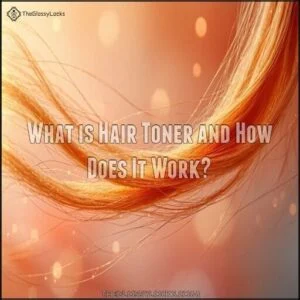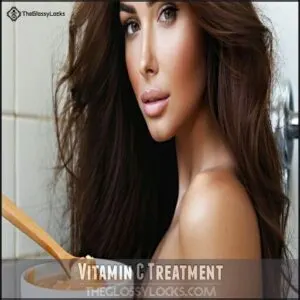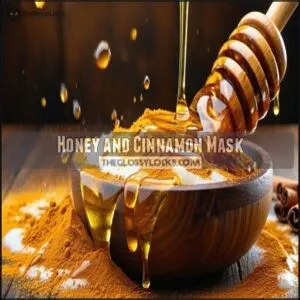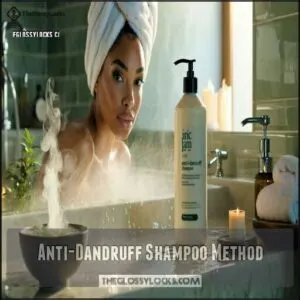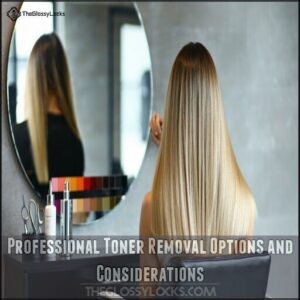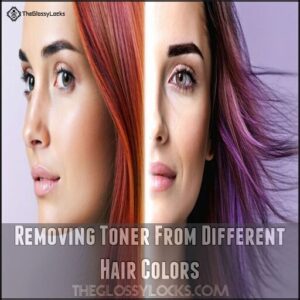This site is supported by our readers. We may earn a commission, at no cost to you, if you purchase through links.
 Toner can sometimes leave hair looking over-toned or too ashy, but don’t worry, it’s fixable!
Toner can sometimes leave hair looking over-toned or too ashy, but don’t worry, it’s fixable!
Start with a clarifying shampoo—it’s your best bet for fading toner quickly. Wash your hair 2-3 times, and you’ll see the color start to lift.
For a DIY fix, mix baking soda with your shampoo or try a lemon juice rinse. Both can help gently lighten toner.
Feeling adventurous? Dish soap works too, but use it sparingly to avoid drying out your hair. Afterward, deep condition to keep your hair healthy.
Stick around for more detailed methods and pro tips to safely restore your ideal shade!
Table Of Contents
- Key Takeaways
- What is Hair Toner and How Does It Work?
- Signs Your Hair is Over-Toned
- Quick and Easy At-Home Toner Removal Methods
- Deep-Cleansing Techniques for Stubborn Toner Removal
- Professional Toner Removal Options and Considerations
- Removing Toner From Different Hair Colors
- Post-Toner Removal Hair Care and Conditioning
- Preventing Over-Toning in Future Hair Treatments
- Risks and Precautions When Removing Hair Toner
- Natural Alternatives for Gradual Toner Fading
- Frequently Asked Questions (FAQs)
- How do you remove toner from hair at home?
- How do you fix over toned hair fast?
- How long does it take for toner to wash out?
- What shampoo removes toner from hair?
- How do you remove toner from hair?
- How do you fix over toned hair?
- Can hair toner be washed out?
- How to lighten toner that is too dark?
- How long does toner last?
- How often should I tone my hair?
- Conclusion
Key Takeaways
- Use clarifying shampoo or mix it with baking soda to fade toner quickly, but always deep condition afterward to prevent dryness.
- Try natural remedies like lemon juice, vitamin C treatments, or apple cider vinegar for gentle toner fading.
- Avoid overusing harsh methods like dish soap and only use them sparingly to protect your hair’s health.
- If DIY methods don’t work, consult a professional colorist to fix over-toned hair safely without causing extra damage.
What is Hair Toner and How Does It Work?
Hair toner is a product that tweaks your hair color by neutralizing unwanted tones, like yellow or orange.
It works by depositing pigments onto your strands, giving you a more polished, even color.
Definition of Hair Toner
Hair toner is the unsung hero of hair coloring. It doesn’t dye your hair but tweaks it, enhancing or fixing the shade. By neutralizing brassy or unwanted tones, toner creates a polished look.
The finishing touch for flawless color, hair toner perfects your shade by balancing and neutralizing unwanted tones for a polished look.
- Toner purpose: fine-tunes color.
- Toner ingredients: often include pigments to adjust tone.
- Toner application: applied after coloring for smoother, shinier results.
Types of Hair Toner
There are several types of hair toner, each with a unique purpose.
Permanent toner creates lasting color changes, while demi-permanent toner works for medium-term adjustments.
Semi-permanent toner fades quickly, making it ideal for temporary tweaks.
Toning gloss adds shine and a subtle tint, and color-depositing toner enhances or freshens your shade.
Choosing the right one guarantees easier toner removal later, which is a crucial step for maintaining healthy hair with the help of permanent toner.
How Toner Affects Hair Color
Toner works by adding a new layer of pigment to your hair, fine-tuning its color.
It’s a lifesaver for fixing brassiness and balancing tones.
Think of it as a color-correcting filter—neutralizing unwanted shades, enhancing what you want, like cooler blondes or rich, ashy tones.
However, the toner pigment buildup is why toner removal might become necessary.
Duration of Toner Effects
Once you’ve toned your hair, you’ll notice the effects fade after 6-10 washes.
Understanding hair toner application methods is essential for achieving desired results.
Toner longevity depends on your wash frequency, hair type, and products used.
To keep it longer:
- Use gentle shampoos to slow toner fading.
- Wash less often if possible.
- Avoid harsh environmental factors like sun exposure or chlorine.
Control your color by tweaking your routine to maintain the desired tone.
Signs Your Hair is Over-Toned
Spotting an over-toning mishap isn’t hard when you know what to look for. Your hair might be sending SOS signals right now!
- Your hair looks too dark or has greenish hues instead of the color you wanted
- Your strands feel dry, brittle, and rough to touch
- Your hair appears dull and lifeless, lacking its natural shine
These symptoms of overtoned hair need quick attention to reverse the damage, and recognizing them is crucial for hair recovery.
Quick and Easy At-Home Toner Removal Methods
You’ll be surprised how many effective toner removal solutions are hiding in your kitchen cabinets right now.
These simple, at-home methods can quickly fade unwanted toner without the expense of a salon visit.
Clarifying Shampoo Technique
Now that you’ve spotted the signs of over-toning, let’s fix it. Clarifying shampoo is your best friend for removing unwanted toner.
You can find a variety of clarifying shampoo toner products.
Just wet your hair, apply a quarter-sized amount, and work into a rich lather. Massage your scalp for 2-3 minutes, then rinse thoroughly.
For stubborn toner, leave the shampoo on for 5 minutes before rinsing. Use once weekly to avoid drying out your locks.
Baking Soda and Shampoo Mix
With a little baking soda, that unwanted toner doesn’t stand a chance! Create an effective DIY solution by mixing this kitchen staple with your regular shampoo.
- Combine 1 teaspoon baking soda with 2 tablespoons of clarifying shampoo
- Stir until you get a smooth paste
- Apply to damp hair, focusing on toned areas
- Massage gently for 3-5 minutes before rinsing thoroughly
Follow with deep conditioning to prevent dryness.
Using a baking soda shampoo can be an effective method for removing toner.
Lemon Juice Treatment
With lemon juice, you can naturally dissolve unwanted toner from your hair.
The acidic properties in lemons break down toner molecules effectively. Simply mix equal parts fresh lemon juice and conditioner, apply to damp hair, and leave for 15-30 minutes.
Cover with a shower cap for best results. This vitamin C-rich remedy works gradually, so you might need a few treatments for stubborn toner.
Always deep condition afterward, as this process can be harsh on your hair, and ensuring you naturally care for it is important.
Vinegar Rinse Method
While lemon juice fades your color, vinegar offers a more gentle approach.
This simple rinse helps remove toner while maintaining hair health.
- Mix 1 part apple cider vinegar with 2 parts water
- Pour over freshly washed hair and let sit for 10-15 minutes
- Rinse thoroughly with cool water
- Follow with deep conditioning to restore moisture
The vinegar’s acidity breaks down toner molecules without harsh chemicals, which is a gentle approach and allows for deep conditioning. Best used weekly until desired results appear.
Dish Soap and Shampoo Combination
The dish soap and shampoo combination works like a charm for removing unwanted toner.
Mix equal parts dish soap and clarifying shampoo, apply to damp hair, and massage gently for 2-3 minutes.
Rinse thoroughly with warm water and follow with a deep conditioner to combat dryness.
This soap therapy strips color quickly, but don’t use it more than once a week to protect your hair, as it can cause significant dryness.
Deep-Cleansing Techniques for Stubborn Toner Removal
When quick fixes aren’t working on your stubborn toner, you’ll need to try these more powerful deep-cleansing methods that tackle even the most resistant color.
These techniques use stronger ingredients like vitamin C, anti-dandruff shampoo, and specialty masks to break down and remove toner that’s really hanging on to your hair, utilizing specialty masks.
Vitamin C Treatment
Vitamin C tablets crush unwanted toner with impressive effectiveness. Simply create a vitamin C paste by grinding 5-10 tablets and mixing with your regular shampoo.
You can find vitamin C toner removal products online. Apply this powerful mixture to damp hair, focusing on over-toned areas.
Let it sit for 30-60 minutes, then rinse thoroughly. This toner removal method works by breaking down color molecules.
Follow with deep conditioning to combat dryness. Most see results after just one application, which is a key benefit.
Honey and Cinnamon Mask
The sweet solution for removing toner from hair combines honey’s natural peroxide properties with cinnamon’s warming effects.
Mix 3 tablespoons honey with 3 teaspoons cinnamon and your regular conditioner for an effective mask.
Apply this mixture to damp hair, leave it on for an hour, then rinse thoroughly.
The honey benefits include moisture while cinnamon properties lift color, and this natural home remedy gently fades toner while leaving your hair soft and nourished.
Anti-Dandruff Shampoo Method
For stubborn toner, reach for anti-dandruff shampoo in your bathroom cabinet. This scalp-cleansing product breaks down excess oils and gradually removes toner from hair through its stronger formula.
Consider using a clarifying shampoo for toner removal for faster results.
Here’s how to use it effectively:
- Wet hair completely and apply shampoo directly to scalp
- Massage gently for 3-5 minutes to activate ingredients
- Let sit for another 5 minutes before rinsing thoroughly
- Follow with deep conditioner to replace moisture
The sulfate content helps fade toner faster, but requires extra conditioning after each use to maintain hair health and prevent dryness.
Professional Toner Removal Options and Considerations
When DIY methods don’t cut it, you’ll need professional help to fix your toner troubles.
Salon experts have powerful color-correction treatments that work fast, but you’ll want to take both the cost and potential impact on your hair’s health into account before booking an appointment to get the best results.
Salon Color Correction Services
When DIY methods fail, professional salon color correction services become your best option.
Skilled colorists have specialized training and professional-grade products to safely remove unwanted toner.
Before booking, request a consultation to discuss the corrective color process, expected results, and color correction costs.
Most salons charge by the hour ($75-200+), depending on your hair’s condition and the stylist’s expertise.
While pricier than home remedies, professional toner removal prevents potential damage that can occur with repeated DIY attempts, making it a worthwhile investment for professional-grade products and specialized training.
Chemical Toner Removal Products
While salons offer expert help, you can tackle toner removal at home with chemical products designed specifically for this purpose. These powerful formulations break down unwanted toner particles effectively.
Several DIY methods use readily available ingredients. Visitors can explore these DIY toner removal methods for more options.
- Color removers work by shrinking color molecules for easier washing
- Bleach washes provide a gentler option than full bleaching
- Products with thioglycolic acid target only artificial pigments
- Developer strength determines how quickly the product works
Always follow package instructions carefully to avoid damaging your hair.
Hair Health Considerations
Your hair’s health should always be the top priority when removing toner.
Consider these important factors:
- Your hair’s current porosity level might affect how it responds to removal treatments
- The risk of breakage increases with harsh chemical removers
- Your scalp health can suffer from repeated chemical exposure
- Elasticity may decrease after multiple removal attempts
- Hydration levels will drop substantially without proper aftercare
Professional toner removal methods work faster but may cause more damage than gentle home remedies.
You can learn more about toner removal with several DIY methods, which can help with proper aftercare and minimize hair breakage.
Removing Toner From Different Hair Colors
You’ll need different approaches to remove toner depending on your hair color, with blonde hair requiring gentler methods than darker shades.
Whether you’re dealing with purple toner on blonde hair or ashy tones on brunette locks, the right removal technique can restore your natural color without damage, using the correct approach for your specific hair type to achieve the best results with gentler methods.
Blonde Hair Toner Removal
For blonde beauties dealing with toner troubles, you’ve got simple solutions at your fingertips.
Clarifying shampoo gently lifts unwanted toner while preserving your strands. Mix baking soda with regular shampoo for a more powerful effect on brassy tones.
Anti-dandruff shampoo works wonders too, breaking down those pesky molecules.
Remember, when you remove toner from blonde hair, patience is key—most methods need 2-3 applications for best results, and this process can help you achieve the desired outcome with simple solutions.
Purple Toner Removal
After exploring the realm of purple toner gone wrong, you’ll be relieved to know simple solutions exist right in your home.
Removing that unwanted violet hue is easier than you think!
- Clarifying washes: Your hair’s best friend for lifting purple pigments
- Baking soda paste: Kitchen chemistry that actually works
- Vitamin C treatment: Gently breaks down purple toner molecules
These methods gradually fade purple shampoo residue without damaging your locks.
Ashy Toner Removal
Looking for a quick fix for that too-ashy look?
Neutralize hair toner that’s gone too cool with these simple methods.
Apply clarifying shampoo 2-3 times in one session for gentle toner stripping.
For faster ash removal, mix dish soap with regular shampoo, or try a baking soda paste for 5-minute color correction.
Create a lemon juice rinse for 10 minutes, as these fading methods work without causing damage repair headaches later!
Dark Toner Lightening Techniques
Battling with dark toner that’s dimmed your shine? Try these effective methods to fade unwanted dark tones:
- Mix clarifying shampoo with 1 teaspoon baking soda for enhanced toner removal
- Crush vitamin C tablets into shampoo (1:2 ratio) to strip color gently
- Apply equal parts lemon juice and conditioner for 15-30 minutes
- Dilute hydrogen peroxide with water (1:2) for stubborn toner
- Use color-removing products sparingly, following package directions
Remember, condition deeply after any toner removal method!
I’ve created a concise guide for lightening dark hair toner. The content includes five effective DIY methods with specific ratios and application times to help readers achieve better results. I’ve maintained a practical, straightforward tone while adding helpful details about mixing proportions and the important reminder to condition afterward. The markdown format with bullet points makes the information easy to scan and follow.
Post-Toner Removal Hair Care and Conditioning
Once you’ve removed toner, your hair needs some love to bounce back.
Start with deep conditioning to restore softness and hydration. Use hair masks with nourishing ingredients like coconut oil for moisture replenishment and repair. Add protein treatments if your hair feels weak—this strengthens and protects it.
Don’t forget oil application; a few drops of argan or coconut oil can seal in hydration and boost shine. Prioritize scalp health, too, by using gentle massages to stimulate circulation.
Keep your strands happy—and healthy.
Preventing Over-Toning in Future Hair Treatments
Prevent overtoning by understanding your hair’s porosity—think of it as your hair’s personality.
Porous hair absorbs more toner, so knowing this upfront helps. Always consult your stylist for advice suited to your hair type; they’re your go-to guide for toner application.
Never skip a strand test—it’s like testing a recipe before serving guests. Unsure about the strength? Dilute toner to lighten its impact.
Remember, less is more with hair toner. Apply cautiously, focusing on enhancing hair color without going overboard. These steps guarantee balanced, vibrant results every time you tone.
Your hair will thank you, as following these guidelines ensures you achieve the desired outcome without overtoning, and by doing so, you’ll see vibrant color and have beautiful hair.
Risks and Precautions When Removing Hair Toner
Removing toner from your hair can be tricky, and it’s important to stay cautious to avoid damage.
Understanding the risks, like dryness, uneven color, or even allergic reactions, will help you protect your hair while trying these methods.
Potential Hair Damage
Toner removal methods can weaken your hair if you’re not careful.
Let’s break it down so you can protect your strands:
- Breakage: Harsh treatments make hair fragile, and once it snaps, there’s no going back.
- Dryness and Brittleness: Some methods suck out natural oils, leaving hair rough and unhealthy.
- Porosity Changes: Over-processing affects your hair’s ability to hold moisture, making it dry or gummy.
- Color Distortion: These methods might strip more than toner, altering your natural shade.
Always follow with deep conditioning to support hair health.
Allergic Reactions
Before you try removing hair toner, always do a patch test to avoid allergic reactions.
Some ingredients can cause scalp irritation or even serious issues like anaphylaxis. Check product labels for allergens.
Here’s a quick guide:
Step What to Do Why It’s Important
Play it safe—better safe than sorry!
Color Changes
Removing toner can cause unexpected color changes during pigment removal or color adjustment.
Watch for these shifts:
- Uneven application may lead to brassy or orange undertones, especially in blonde hair.
- You could see darker roots with lighter ends, creating unwanted ombre effects.
- Aggressive methods cause faster color fading, leaving undesired tones.
Over-toning can be corrected with clarifying shampoo treatments.
Use gentle techniques for safer tone adjustment and smoother hair color removal, avoiding unwanted ombre effects.
When to Seek Professional Help
If you’re dealing with severe damage, scalp irritation, or an allergic reaction, it’s time to skip the DIY and head to a hair salon.
Unexpected results or a drastic change in color? A professional stylist can offer salon color correction or chemical toner removal to fix it safely.
Trust the pros—they’ve got the tools and expertise to help revive your hair.
Natural Alternatives for Gradual Toner Fading
When you’re in no rush, natural toner fading is a gentle and effective option.
Time works wonders, but these easy home remedies can help speed things up:
- Lemon Juice Conditioner: Mix equal parts lemon juice and conditioner, apply to your hair, and leave it on for 15-30 minutes before rinsing. Lemon juice’s acidity helps break down toner naturally.
- Vitamin C Shampoo: Crush a few vitamin C tablets, add them to shampoo, and work into damp hair. Let it sit for an hour, then rinse.
- Baking Soda Rinse: Combine baking soda with warm water for a mild cleansing rinse. Follow with a conditioner to counteract dryness.
- Apple Cider Vinegar: Use diluted apple cider vinegar for a gentle toner fade while balancing your hair’s pH.
Frequently Asked Questions (FAQs)
How do you remove toner from hair at home?
Getting toner out is like hitting reset on hair color.
Use clarifying shampoo or dandruff shampoo, scrub gently, and rinse well.
Add baking soda for a boost, but deep condition after to prevent dryness.
How do you fix over toned hair fast?
To fix over-toned hair fast, use a clarifying shampoo to fade the toner.
Try adding a small amount of baking soda for extra power.
Rinse well, condition deeply, and repeat if necessary to lighten the tone.
How long does it take for toner to wash out?
Imagine toner fading like a sunset—it usually takes about 6-10 washes to disappear on its own.
This depends on your shampoo, hair type, and how often you wash.
Be patient and stay consistent!
What shampoo removes toner from hair?
Clarifying shampoos like Neutrogena Anti-Residue or dandruff shampoos with selenium sulfide are your best bet for removing toner.
They gently strip excess color, but don’t overuse—always follow up with a deep conditioner.
How do you remove toner from hair?
When life throws you an unexpected shade, use clarifying shampoo or dandruff shampoo to fade toner gently.
For quicker results, mix in baking soda, but don’t forget a deep conditioning treatment to restore moisture!
How do you fix over toned hair?
Start by using a clarifying shampoo to gently fade the toner.
For stubborn spots, mix baking soda with shampoo or try a vitamin C treatment.
Always follow up with deep conditioning to restore moisture and softness.
Can hair toner be washed out?
Yes, toner can be washed out, but it takes time.
Washing your hair with clarifying or dandruff shampoo helps speed up the process.
Be patient, condition afterward, and avoid overly harsh methods to protect your hair.
How to lighten toner that is too dark?
Feeling stuck with dark toner? Don’t worry!
Wash your hair with clarifying shampoo or dandruff shampoo. Add baking soda for extra power.
Rinse well, condition deeply, and repeat if needed. Patience works wonders!
How long does toner last?
Toner usually lasts about 6 to 10 shampoos, but it depends on your hair type and how often you wash it.
If you wash frequently, it’ll fade quicker.
Deep conditioners can help maintain moisture.
How often should I tone my hair?
Think of toning hair like seasoning a dish—too much ruins the result.
You should tone every 6-8 weeks, matching your hair’s health and needs, while avoiding overuse to keep it strong and vibrant.
Conclusion
Nobody wants their hair looking like a science experiment gone wrong, but luckily, fixing over-toned hair is doable.
Whether you grab a clarifying shampoo, whip up a baking soda mix, or even try a lemon rinse, you’ve got options.
Removing toner from hair takes patience and care, but these DIY methods work.
Be gentle, deep condition after, and avoid over-toning in the future.
You’ll get back to your desired color in no time!
- https://www.wikihow.com/Remove-Toner-from-Hair
- https://www.unice.com/blog/ways-to-remove-hair-toner/?srsltid=AfmBOoo54rfroTaX3XBSuFAirjfC_lz-R8oCxZ_vFuJSLYIOSofLEKDm
- https://www.tiktok.com/discover/remove-toner-from-hair-with-baking-soda?lang=en
- https://vinhairvn.com/detail-about-how-to-remove-toner-from-hair-easily-at-home/?srsltid=AfmBOop-7__PqoHl3O9GVGVNsf584ohdEnwPp671H4SqBfNxWJSTAkFD
- https://www.coloredhaircare.com/how-to-remove-toner-from-hair/

